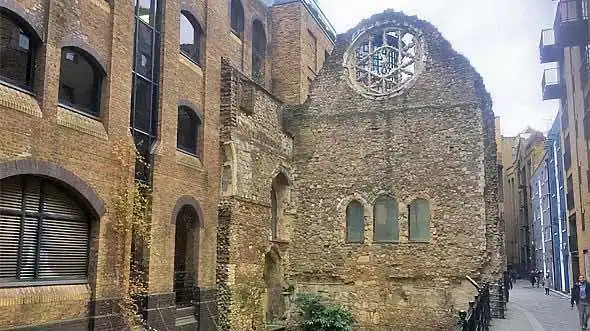
You need to temper your expectations because this isn’t a palace anymore – it’s a wall. So don’t go expecting to see a load of fancy French furniture and Renaissance paintings as you’re walking past the Clink because there’s none of that – it’s literally just a ruined wall and a few flower pots on the floor. But it’s still worth a quick look if you happen to be in the vicinity.
The Bishop of Winchester
I’m going to have to go back a few years to tell this story… all the way back to 871 AD when King Alfred had his capital at Winchester. Back in those days the Bishop of Winchester doubled-up as his treasurer so he was a bit like our modern-day chancellor – a cross between the Pope and Gordon Brown, if you can imagine such a thing.
Two hundred years later the Normans started basing themselves out of London so the bishop found himself travelling back and forth across the south of England every week. And remember they didn’t have any trains in those days (although I’m wondering whether his horses were quicker than our trains – they might have been). That’s when he decided to build himself a posh new headquarters at the end of London Bridge.
Winchester Palace
Because his new palace was outside the city walls he was able to rule the surrounding streets like a mafia don. Southwark was his Sicily, and his writ stretched from here all the way down to the Tate. Being a man of God you might have expected him to fill it with apothecaries, almshouses, chapels and churches, but nope – he brought in bear-baiting pits, brothels, gambling dens, tawdry taverns and theatres – all the stuff that was banned across the bridge. He even had his own personal prison called the Clink which you can go and visit afterwards (it’s not the historical one, just a London Dungeon-like remake). With all the fines and bribes and taxes he was collecting his palace fattened into one of the largest and most important buildings in all of medieval London.
Remains of the Great Hall
But that was then. That was when it was still standing. Now it’s all been swept away and the only bit left is a gable from the Great Hall and the short stumps of a cellar underneath. They’ve put some flower beds across the bottom to brighten it up a bit, but you’ve got to use your imagination to see the feast that Thomas Beckett had before he travelled down to Canterbury that final time. Try and picture the wedding celebrations that James I of Scotland enjoyed after getting hitched to his English missus in Southwark Cathedral. They both happened right here in this very room.
The rest of the palace was gradually abandoned or turned into tenements and burned down in the 19th-century. What was left of the walls were then bricked up inside the new wharves and warehouses that dotted up along the Thames, and only rediscovered when the Luftwaffe dropped some bombs on top.
. You might like to visit the Clink Prison Museum afterwards. And if you like this one-wall palace then you might like to read my review of the Roman bath, which contains a one-wall monastery
More things to do on Bankside



Best of Bridgerton - Candlelight Concert at Southwark Cathedral


